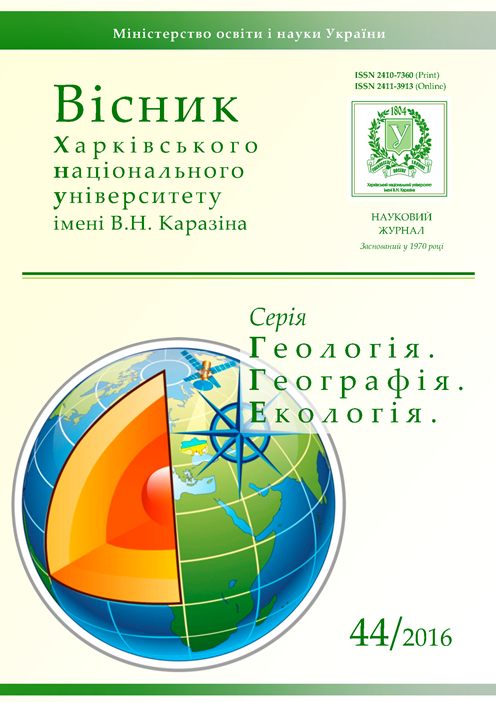Application of ecological footprint methodology in a constructive and geographical research
Abstract
The article identifies the aspects of using the ecological footprint (EF) methodology in constructive and geographical research while doing environmental impact assessment in Ukrainian regions. It analyzes how the methodology considers the complexity of environmental impacts, what spatial patterns can be determined, and how EF can be useful in decision-making.
The theoretical foundation of the research are publications of the recognized environmentalists retrieved from the Science Direct. The calculations for further analysis are made based on data available at the State Statistics Service of Ukraine and the State Service of Ukraine for Geodesy, Cartography, and Cadastre.
The research includes three stages: 1) analysis of the strengths and weaknesses of the EF methodology; 2) calculation of EF and biocapacity in Ukrainian regions in 2000-2012 and identification of the trends; and 3) consideration of usefulness of the methodology for making decisions.
In the scope of the study, EF is successfully used to assess the environmental impact of the Ukrainian population. It allows to draw the conclusion that the current consumption patterns determine the unstable use of natural resources and ecosystem services. Thus, the difference is imported from other territories, so the citizens become recipients of natural goods produced outside the country.
Two patterns were identified as a result of the regional EF and biocapacity trends: 1) the values change in different directions and 2) unidirectionally. The latter pattern is important for decision-makers because they should take action when the regional biocapacity decreases, while the environmental pressure rises, which is true for 7 Ukrainian regions in the studied period.
Downloads
References
2. Wackernagel, M., Rees, W. (1998). Our Ecological Footprint: Reducing Human Impact on the Earth. New Society Publishers, 176.
3. Lin, D., Wackernagel, M., Galli, A., Kelly, R. (2015). Ecological Footprint: Informative and evolving – A response to van den Bergh and Grazi (2014). Ecological Indicators, 58, 464-468. doi: http://dx.doi.org/10.1016/j.ecolind.2015.05.001
4. Van den Bergh, J. C. J. M., Verbruggen, H. (1999). Spatial sustainability, trade and indicators: an evaluation of the ‘ecological footprint’. Ecological Economics, 29(1), 61-72. doi: http://dx.doi.org/10.1016/S0921-8009(99)00032-4
5. Van den Bergh, J. C. J. M., Grazi, F. (2015). Reply to the first systematic response by the Global Footprint Network to criticism: A real debate finally? Ecological Indicators, 58, 458-463. doi: http://dx.doi.org/10.1016/j.ecolind.2015.05.007
6. Galli, A. (2015). On the rationale and policy usefulness of Ecological Footprint Accounting: The case of Morocco. Environmental Science & Policy, 48, 210-224. doi: http://dx.doi.org/10.1016/j.envsci.2015.01.008
7. Lambrechts, W., Mulà, I., Ceulemans, K., Molderez, I., Gaeremynck, V. (2013). The integration of competences for sustainable development in higher education: an analysis of bachelor programs in management. Journal of Cleaner Production, 48, 65-73. doi: http://dx.doi.org/10.1016/j.jclepro.2011.12.034
8. Gryshchenko, N.V. (2014). Environmental management education: international traditions and Ukrainian experience. Problems of Continuous Geographical Education and Cartography, 20, 148–153.
9. Loiseau, E., Junqua, G., Roux, P., Bellon-Maurel, V. (2012). Environmental assessment of a territory: An overview of existing tools and methods. Journal of Environmental Management, 112(0), 213-225. doi: http://dx.doi.org/10.1016/j.jenvman.2012.07.024
10. Gryshchenko, N. V. (2014). Otsínyuvannya vídnosin lyudini í navkolishn'ogo seredovishcha v Ukraí̈ní kríz' prizmu yekologíchnogo slídu [Human-environmental relationship in Ukraine through the prism of ecological footprint]. Ukrainian Geographical Journal, 2, 44-50. doi: http://dx.doi.org/10.15407/ugz2014.02.044
11. Grishchenko, N. V. (2014). Otsenka nagruzki na okruzhayushchuyu sredu v Ukraine na regional'nom urovne metodom ekologicheskogo futprinta [Environmental impact assessment in Ukraine at regional level using eco-logical footprint method]. Geopolitics and Ecodynamixs of Regions, 2 (10), 489-493.
12. The State Statistics Service of Ukraine. Available at : http://www.ukrstat.gov.ua
13. Derzhavna sluzhba Ukraí̈ni z pitan' geodezíí̈, kartografíí̈ ta kadastru [the State Service of Ukraine for Geodesy, Cartography and Cadastre]. Available at : http://land.gov.ua
14. Toth, G., Szigeti, C. (2016). The historical ecological footprint: From over-population to over-consumption. Ecological Indicators, 60, 283-291. doi: http://dx.doi.org/10.1016/j.ecolind.2015.06.040
15. Van Vuuren, D. P., Smeets, E. M. W. (2000). Ecological footprints of Benin, Bhutan, Costa Rica and the Netherlands. Ecological Economics, 34(1), 115-130. doi: http://dx.doi.org/10.1016/S0921-8009(00)00155-5
16. Bakkes, J. A. (1994). An Overview of Environmental Indicators: State of the Art and Perspectives: Environmental Assessment Sub-Programme, UNEP/Earthprint, 72.
17. Gryshchenko, N.V. (2015). Constructive-geographical aspects of anthropogenic environmental impact assessment in Ukrainian regions in 2000-2012. "Economics for Ecology" - ISCS'2015. Proceeding of 21st International Scientific Conference. Sumy (Ukraine), 38-40.
18. Global Footprint Network. Country Trends: Ukraine 2015. Available at : http://www.footprintnetwork.org/en/index.php/GFN/page/trends/ukraine/
19. Niccolucci, V., Tiezzi, E., Pulselli, F. M., Capineri, C. (2012). Biocapacity vs Ecological Footprint of world regions: A geopolitical interpretation. Ecological Indicators, 16, 23-30. doi: http://dx.doi.org/10.1016/j.ecolind.2011.09.002
20. Intended Nationally-Determined Contribution (INDC) of Ukraine to a New Global Climate Agreement. Available at : http://www4.unfccc.int/submissions/INDC/Published%20Documents/Ukraine/1/150930_Ukraine_INDC.pdf





